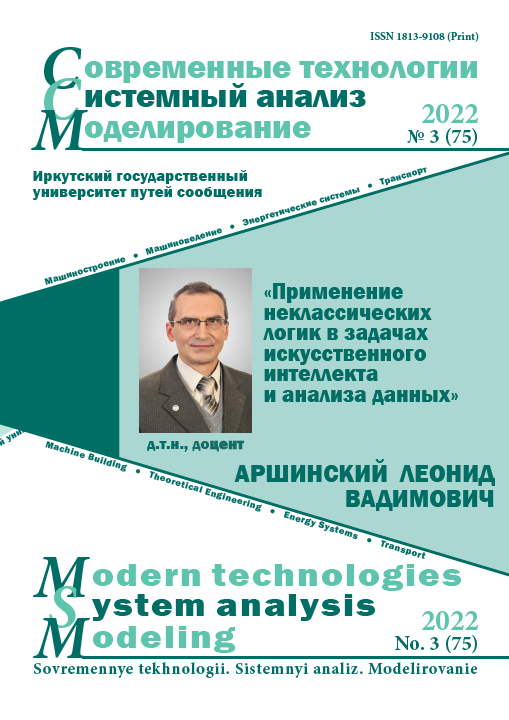Simulation modeling and evaluation of processing capacity of Busan transport hub elements
Keywords:
simulation modeling, terminal and logistics infrastructure, transport hub, Busan portAbstract
The organization of the Trans-Korean Railway with access to the continental railway network will allow the formation of new transport and logistics chains in which the foreign trade container traffic will be concentrated in the Busan transport hub (Republic of Korea). The main international container lines pass through the port Busan, where containers are transshipped from the ports of Southeast Asia and China to sea vessels for delivery to the Far Eastern ports of Russia, which is the main link in the transport and logistics chains of parallel imports. Today, the terminal and logistics infrastructure of the port Busan cannot manage the processing of increasing volumes of container traffic, sea and land transport is idle waiting for technological operations, which leads to logistical risks. The purpose of this article is to determine the reserves of the processing capacity of the Busan transport hub, taking into account the reorientation of part of the container traffic to rail transport. To achieve this goal, a program was developed to assess the processing capacity of the elements of the transport hub with the change in container traffic volume. The objectives of this study are to analyze the volume of container processing in the port Busan, to develop a technological scheme for the interaction of infrastructure facilities and to simulate the operation of subsystems of the Busan transport hub. The subject of this study is the transport and terminal logistics infrastructure of the Busan transport hub. Theoretical and mathematical research methods, including modeling, visualization and comparison, are used in this work. The article presents the results of two modeling scenarios - with existing volumes of work and with infrastructural re-equipment for processing future container flow. A phased development of the processing capacity of the Busan transport hub is proposed, including infrastructure modernization, organizational, technological and technical measures.
References
Ли Т.Е., Король Р.Г. Развитие транспортного узла Пусан для организации транскорейских железнодорожных перевозок // Изв. Транссиба. 2021. № 1 (45). С. 122–133.
A study to establish a complex logistics network connecting port-continental railways / E.K. Lee, J.W. Seo, G.S. Kil et al. // National Research Council for Economics, Humanities and Social sciences. 2018. Vol. 61. Р. 146.
Container Statistics of Busan Port 2021 // IAPH : site. URL: https://www.iaphworldports.org/memberports/busan-port-authority/ (дата обращения: 8.09.2022).
Светличная С.А. Совершенствование системы распределения международных грузопотоков внутри припортового транспортного узла // Технологический аудит и резервы производства. 2013. Т. 5. № 5 (13). С. 12–14.
Свидетельство о регистрации программы для ЭВМ 2022610998, Российская Федерация. Программа оценки перерабатывающей способности элементов транспортного узла при изменении объемов контейнеропотока / Р.Г. Король, Т.Е. Ли: № 2022610264 : заявл. 12.01.2022 : опубл. 18.01.2022. Бюл. №1. 1 с.
Козлов П.А., Колокольников В.С., Копылова Е.В. Об имитационном моделировании и имитационных системах // Транспорт Урала. 2019. № 1 (60). С. 3–6.
Новиков П.А. Имитационной метод динамического согласования (И-МДС) как аппарат оптимизации сложных технологических процессов на транспорте // Транспорт Урала. 2008. № 3 (18). С. 10–12.
Клименко В.В., Морозов А.Н., Проценко О.Д. Моделирование логистической инфраструктуры транспортного узла // Логистика и управление цепями поставок. 2014. № 1 (60). С. 21–29.
Mathematical modeling of cargo flow distribution in a regional multimodal transportation system / O. Chislov, V. Bogachev, A. Kravets et al. // Transport Problems. 2021. Vol. 16, № 2. Р. 153–165.
Ташлыкова А.И. Имитационное моделирование для оценки влияния факторов на продолжительность простоя груза в транспортном узле // Международный научно-исследовательский журнал. 2017. № 12-5 (66). С. 156–160.
Нечипорук М.В., Анисимов В.А. Имитационное моделирование развития Ванино-Совгаванского мультимодального транспортного узла // Бюл. результатов науч. исслед. 2022. № 3. С. 73–88.
Шрамко А.П. Моделирование пропускной способности объединенного транспортного узла с учетом увеличения грузопотоков // Эксплуатация морского транспорта. 2016. № 2 (79). С. 16–24.
Копылов М.А. Повышение резерва пропускной способности транспортного узла // Молодой исследователь Дона. 2020. № 2 (23). С. 35–40.
Determining values of design parameters for a rail transportation terminal in a container port / B.J. Jeong, B.K. Lee, K.H. Kim et al. // Korean institute of industrial engineers. 2007. Vol. 20, №. 4. Р. 469–478.
Куфтинова Н.Г. Возможности использования имитационного моделирования для анализа транспортных узлов // Транспортное планирование и моделирование : сб. тр. II Междунар. науч.-практ. конф. Санкт-Петербург, 2017. С. 175–179.
Андронов С.А., Ульвачева О.В. Оценка и повышение пропускной способности транспортного узла посредством имитационного моделирования в среде PTV VISSIM // Системный анализ и логистика. 2022. № 2 (32). С. 113–129.
Володарец Н.В., Белоусова Т.П. Имитационное моделирование рабочих процессов в транспортном узле в условиях эксплуатации на основе anylogic // Современные инновационные технологии подготовки инженерных кадров для горной промышленности и транспорта. 2018. № 1 (5).С. 244–248.
Ли Т.Е., Король Р.Г. Обоснование этапности развития транспортного узла Пусан (Республика Корея) в условиях роста объема перевозок // Транспорт Урала. 2021. № 4 (71). С. 52–57.
Рудин Р.Ю. Решение транспортных задач с помощью имитационного моделирования // Достижения науки и образования. 2016. № 11 (12). С. 12–16.
Рахмангулов А.Н., Муравьев Д.С. Сценарный подход к развитию морской портовой инфраструктуры с использованием имитационного моделирования // Проблемы инфраструктуры транспортного комплекса : материалы Междунар. науч.-техн. конф. Санкт-Петербург, 2015. С. 108–112.
Мазуренко О.И., Русинов И.А. Моделирование тылового грузового фронта морского угольного терминала // Вестн. гос. ун-та морского и речного флота им. адмирала С.О. Макарова. 2021. Т. 13. № 5. С. 636–650.
Хашев А.И., Мамаев Э.А., Гуда А.Н. Комбинированное имитационно-аналитическое моделирование в транспортно-логистических системах // Вестн. Ростов. гос. ун-та путей сообщ. 2022. № 1 (85).С. 117–125.


